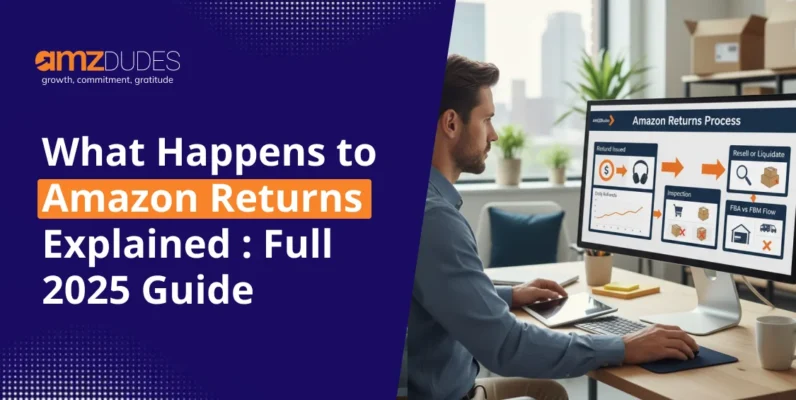Key Takeaways
- Amazon introduces a new Returns Processing Fee (effective June 2024): FBA products with high return rates will now incur category-specific fees ranging from 2.9% to 12.8%, based on size tier and weight, pushing sellers to monitor and reduce excessive returns.
- Returnless refunds and inventory automation bring efficiency: Sellers can now create custom refund rules and automate the handling of unsellable inventory, helping cut costs on low-value or fragile returns.
- Tighter reimbursement claim windows demand faster action: Claim periods for lost or damaged FBA inventory have been shortened to 15–120 days, making regular audits and faster reconciliation essential.
- Global and flexible return handling improves customer trust: Amazon’s new local return addresses and custom restocking fee options help sellers expand internationally and align costs with actual handling effort.
- Seller performance and compliance now directly impact profitability: Metrics like return rate and NCX score are more closely tied to account health, meaning data tracking, listing accuracy, and proactive return management are key to staying competitive.
Amazon changing return policy for FBA sellers is something every FBA seller must be aware of. Amazon return policy change 2025 from 2024 has brought so many leniencies as well challenges for Amazon FBA sellers. Knowing the nits and grits of Amazon new return policy 2025 and adapting accordingly is the only way to stay competitive in 2025.
This article will walk you through the Amazon return policy 2025, acknowledge you with methods to lower down your return rates. By the end of this blog, you will be able to conclude the benefits and challenges linked to this Amazon return policy change 2025.
Key Amazon Return Policy Change 2025
1. Return Processing Fee
Amazon introduced a Returns Processing Fee for all FBA products except apparel and shoes that record a high return rate within their category. This fee is designed to offset the operational costs of processing returns and reduce environmental waste caused by excessive shipping.
The fee applies only when a product’s return rate exceeds its category-specific threshold, which ranges between 2.9% and 12.8% depending on product type.
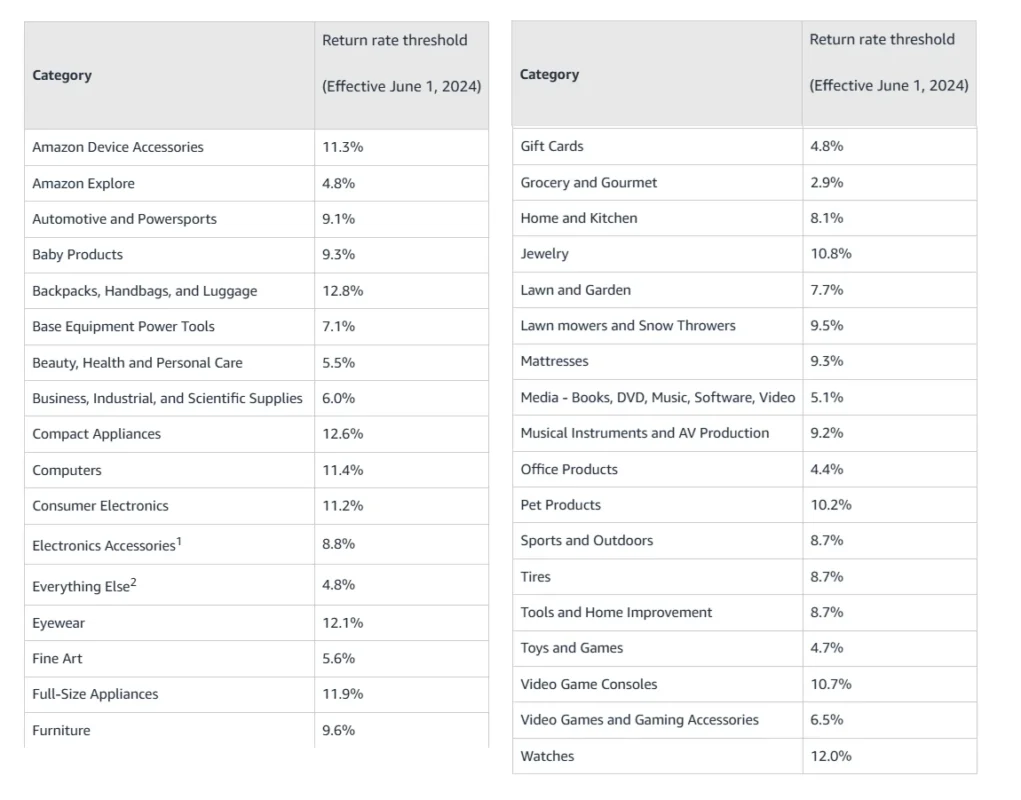
The return rate is calculated as the percentage of shipped units in a given month that are returned during that month and the following two calendar months. Amazon then charges a fee per returned unit above the threshold, based on the item’s size tier and shipping weight.
For example, if you ship 1,000 units in June and 120 are returned by the end of August, and your category’s return rate threshold is 10%, Amazon will only charge the Returns Processing Fee on the extra 20 units that exceed that limit. The fee will appear on your account between September 7 and 15.
Exemptions apply for:
- Products shipping fewer than 25 units per month
- Items enrolled in the FBA New Selection Program (waived for up to 20 units per parent ASIN)
- Apparel and shoes, which are charged per returned unit regardless of threshold
Fee rates vary by product size tier. Small standard items (2–4 oz) may incur around $1.84 per returned unit, while large standard (12–16 oz) products can reach $3.39, and bulky items up to $8.98.
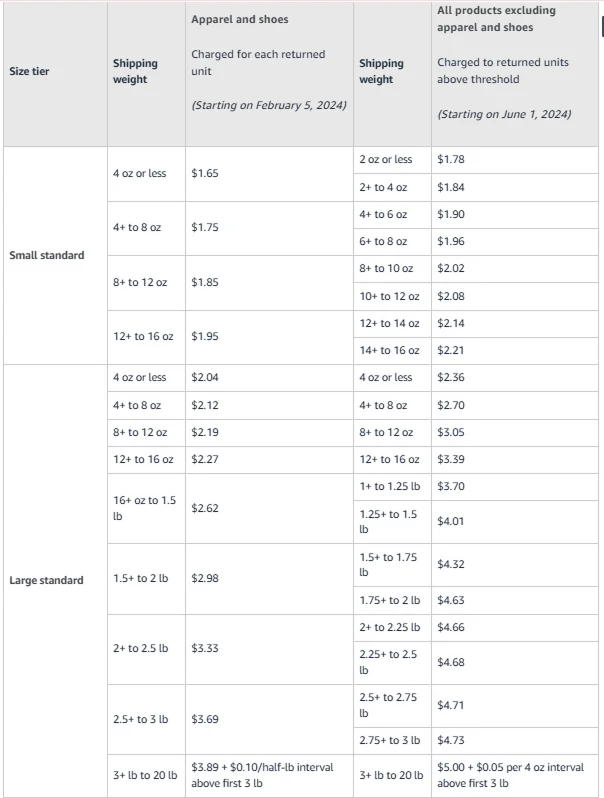
This new fee makes return-rate monitoring a financial necessity. Sellers must regularly review FBA Returns reports to compare product return rates against category thresholds, identify problem SKUs, and take corrective measures in listing accuracy, packaging, and product quality to maintain healthy profit margins.
2. Returnless Refund Expansion & FBA Inventory Controls
Amazon is expanding its Returnless Refund program, giving sellers greater authority to issue refunds automatically without requiring customers to ship the product back. This is particularly useful for low-cost, bulky, or fragile items where return shipping outweighs item value.
Sellers can now create custom rules inside Seller Central by navigating to “Settings”, then “Return Settings” and look up for “Resolution” section. There click on “Create a Returnless Resolution Rule” in order to define:
- Price thresholds (e.g., under $30)
- Product categories
- Eligible return reasons (e.g., damaged, incorrect item)
- Return window limits
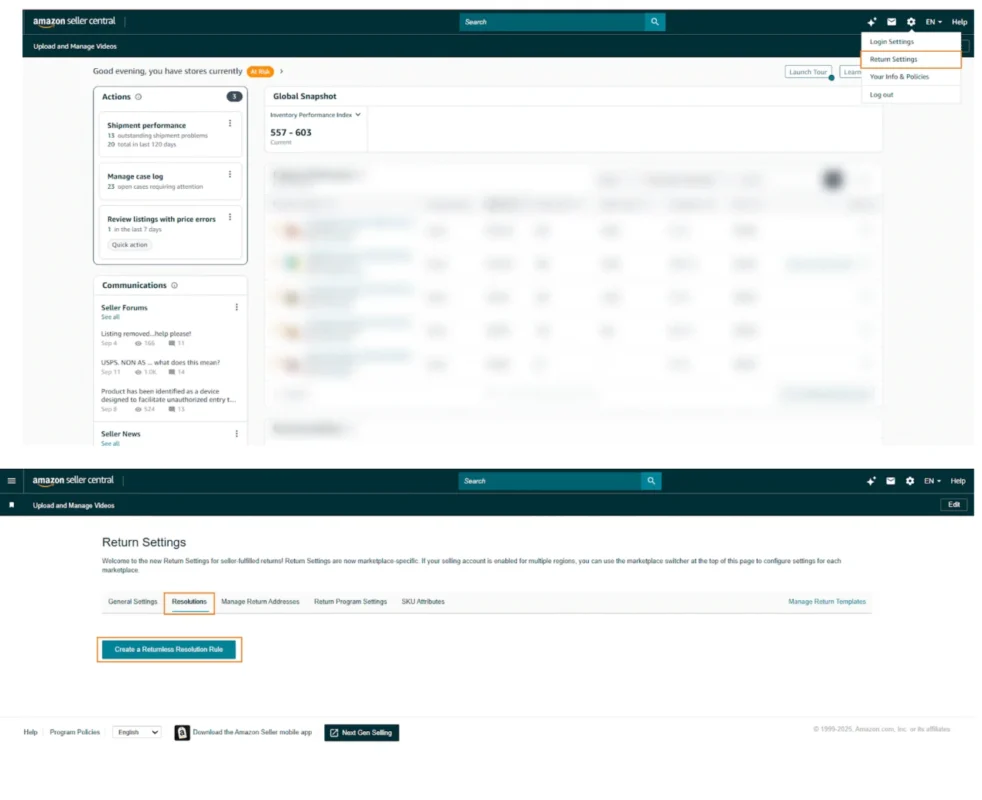
Additionally, Amazon has introduced new FBA inventory controls which allow sellers to pre-select what happens when returned items are deemed unsellable, automatically returned, disposed, or liquidated. This automation reduces manual workload and warehouse congestion, while also minimizing storage costs for unsellable SKUs.
3. Extended Return Windows
In one of the most operationally significant updates, Amazon has reduced the reimbursement claim windows for FBA sellers. This means you must act faster to recover costs for lost or damaged inventory.
New time limits include:
- Fulfillment Center Loss or Damage: 60 days (previously up to 18 months)
- Customer Returns: 60–120 days post-refund
- Removal Orders or Transit Losses: 15–75 days
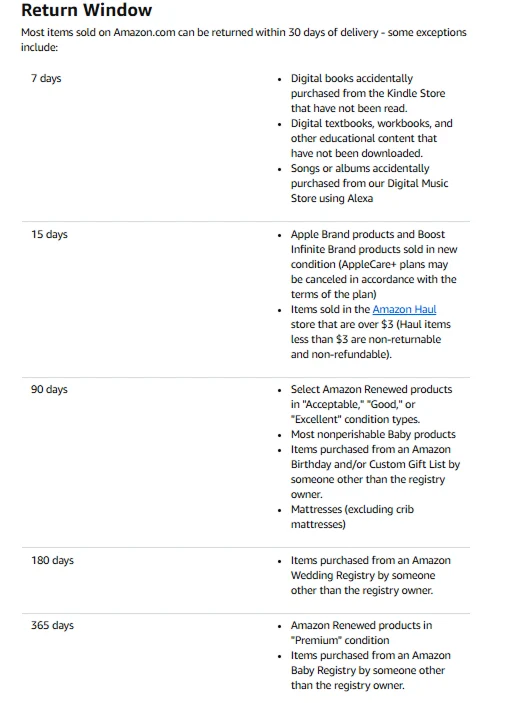
If sellers miss these windows, they lose reimbursement eligibility even when the loss is clearly Amazon’s fault. To adapt, FBA brands must now audit reimbursements weekly using the FBA Inventory Reimbursement Reports or specialized tools like Seller Assistant App. These tighter deadlines reflect Amazon’s focus on accountability and system efficiency.
4. Simplified International Returns
Amazon has simplified international return handling by enabling sellers to set up local return addresses in supported markets. This major change eliminates the need for customers to ship returns across borders. This has dramatically reduced time, cost, and logistical friction.
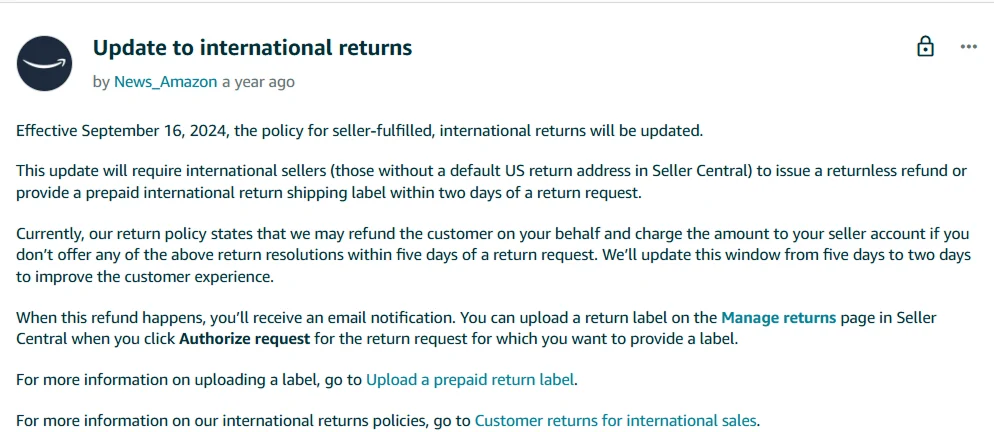
For instance, a customer in Germany can now return an FBA product purchased from a U.S. seller to a local Amazon-managed facility instead of mailing it back overseas.
This feature not only improves buyer confidence and satisfaction but also expands cross-border selling potential. Sellers looking to grow internationally can now handle post-purchase issues faster and cheaper, with less negative impact on account health.
5. Restocking Fee Customization
Previously, Amazon applied standard restocking fees for all sellers, regardless of product condition or handling complexity. Under the Amazon return policy change 2025, sellers can now set custom restocking fees that align with their actual return-handling costs.
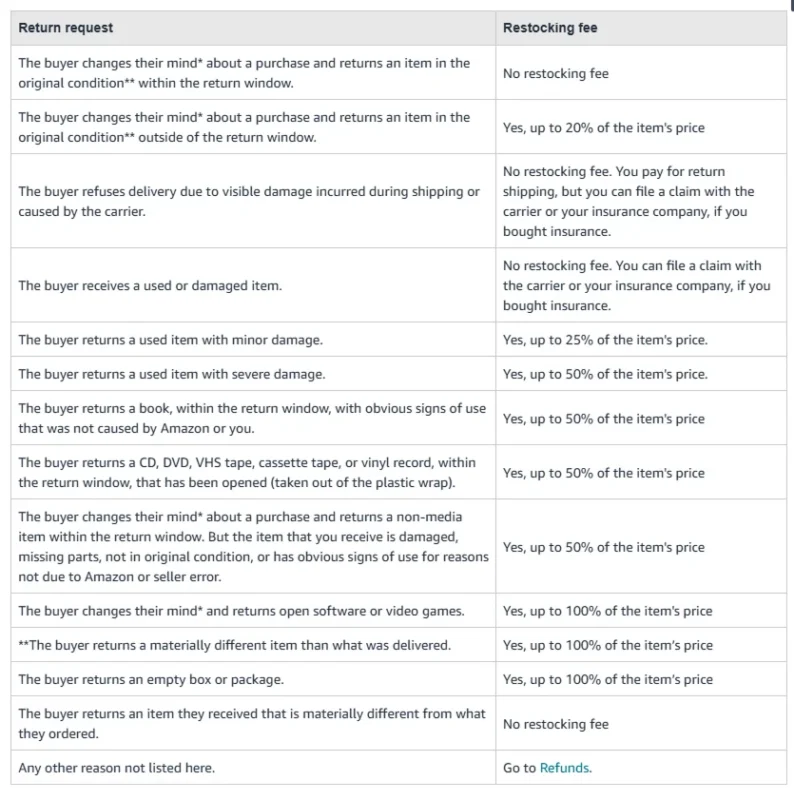
This means you can charge higher restocking percentages for opened, used, or damaged items, and apply lower fees for sealed, resellable goods.
For example, a 20% restocking fee may apply to opened electronics, while only 5% applies to unused items.
This flexibility helps sellers recover fair costs, discourages repeat return abuse, and creates better transparency in the buyer-seller relationship.
6. Enhanced Quality Control & Damaged-Item Reimbursements
Amazon has refined its damaged-item reimbursement workflow to simplify claims and reduce disputes. Returned FBA items are now automatically inspected and photographed upon arrival at fulfillment centers. Sellers receive clearer condition documentation and faster resolution timelines.
If an item is found damaged or unsellable through no seller fault, Amazon automatically initiates reimbursement based on product value and historical sales data.
The updated process minimizes manual claim filing and ensures sellers recover their inventory value more efficiently. It also reduces the number of discrepancies between “Amazon-fulfilled” and “seller-damaged” classifications which has been a recurring pain point for many FBA brands.
7. Extended Return Windows (Holiday & Seasonal Purchases)
Seasonal orders now fall under extended return windows to support higher Q4 demand and gift purchases. Items bought during major events like Prime Big Deal Days, Black Friday, and the holiday season can be returned well into January 2026, often up to January 31.
While this extension increases potential return volume, it also improves buyer confidence and conversion rates during high-traffic shopping periods.
FBA sellers should adjust forecasting and stock allocation to accommodate the longer post-holiday return flow.
How to Prepare and Adapt with Amazon Changing Return Policy
The Amazon return policy change 2025 signals a shift toward more performance-driven seller management.
FBA brands that act early by auditing return patterns, tightening listing accuracy, and automating refund rules will be best positioned to protect profitability and maintain strong account health.
Below are six key action areas to adapt effectively.
1. Audit and Optimize Return Performance
- Start with a detailed return audit to understand why customers are sending items back.
- Review your return rates per ASIN from the Returns Performance Dashboard or FBA Business Reports.
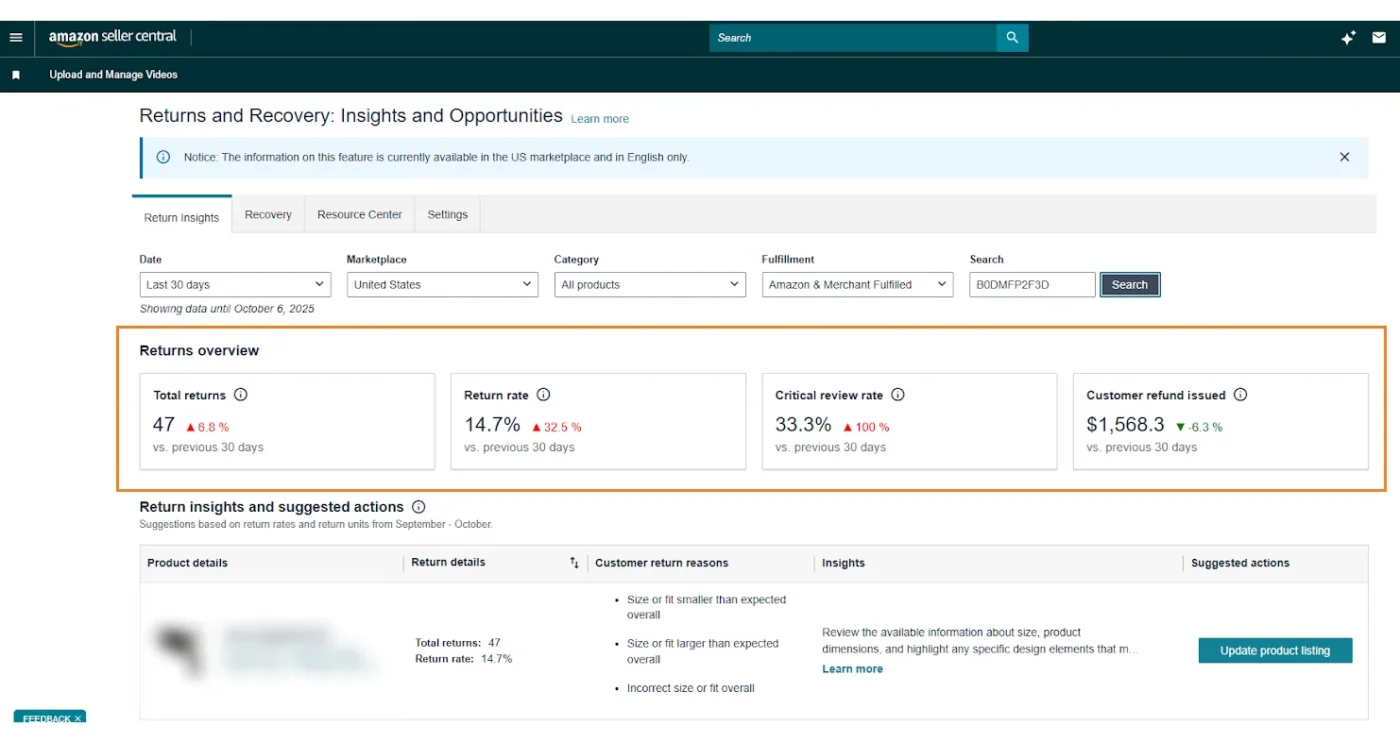
- Segment by category, brand, and price range to identify patterns, for example, apparel fit issues or defective packaging.
- Use the Return Insights Dashboard to break down reasons such as “Not as described,” “Arrived damaged,” or “Wrong item received.”
- High-return SKUs should be investigated for:
- Listing mismatches (size, color, model variants)
- Missing or misleading product details
- Weak images or poor packaging quality
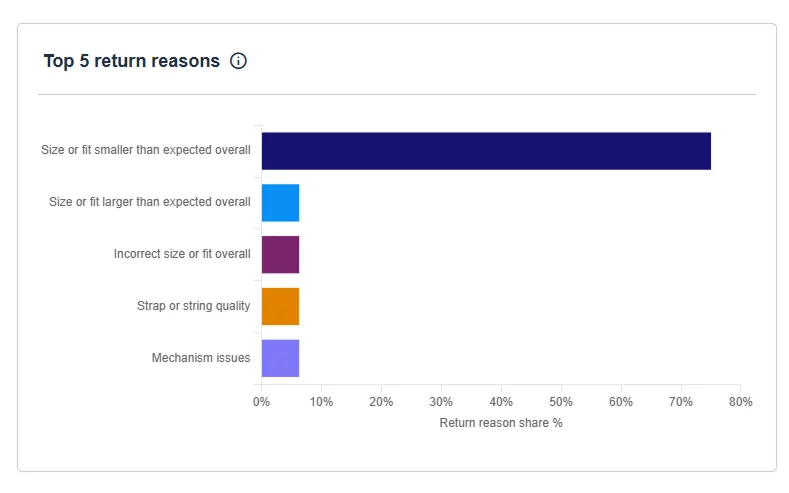
- Implement corrective measures immediately such as refining listings, enhancing visuals, and verifying fulfillment prep steps (bubble wrap, poly bags, etc.).
This proactive approach prevents Return Processing Fee penalties and strengthens long-term Voice of the Customer metrics.
2. Monitor NCX Rate (Negative Customer Experience)
- Your NCX Rate directly measures how many orders generate negative buyer experiences including returns, late deliveries, and complaints. It’s one of the most critical metrics Amazon now uses to assess seller trustworthiness and listing quality.
- You can access it by going to “Performance” and then “Voice of the Customer” in Seller Central.
- Track SKUs labeled as Poor or Very Poor and analyze the reasons behind each flag.
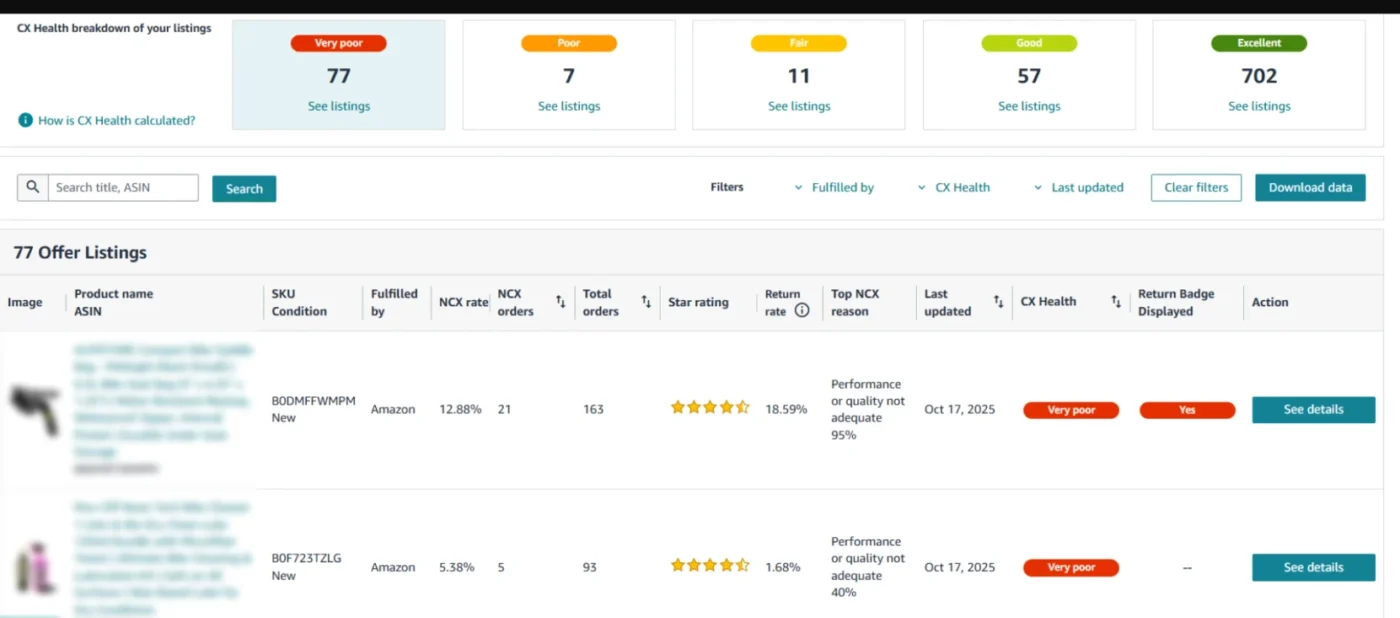
- Focus on improving:
- Packaging Quality: Fragile items should include inner cushioning and “Fragile” FBA prep labels.
- Listing Accuracy: Ensure dimensions, colors, and variant titles match the actual product.
- Fulfillment Precision: Verify correct labeling and avoid commingled inventory to prevent mis-shipments.
Sustained high NCX rates can lead to listing suppression or account health warnings. By tracking weekly and responding to early indicators, sellers can fix root causes before they escalate into policy violations.
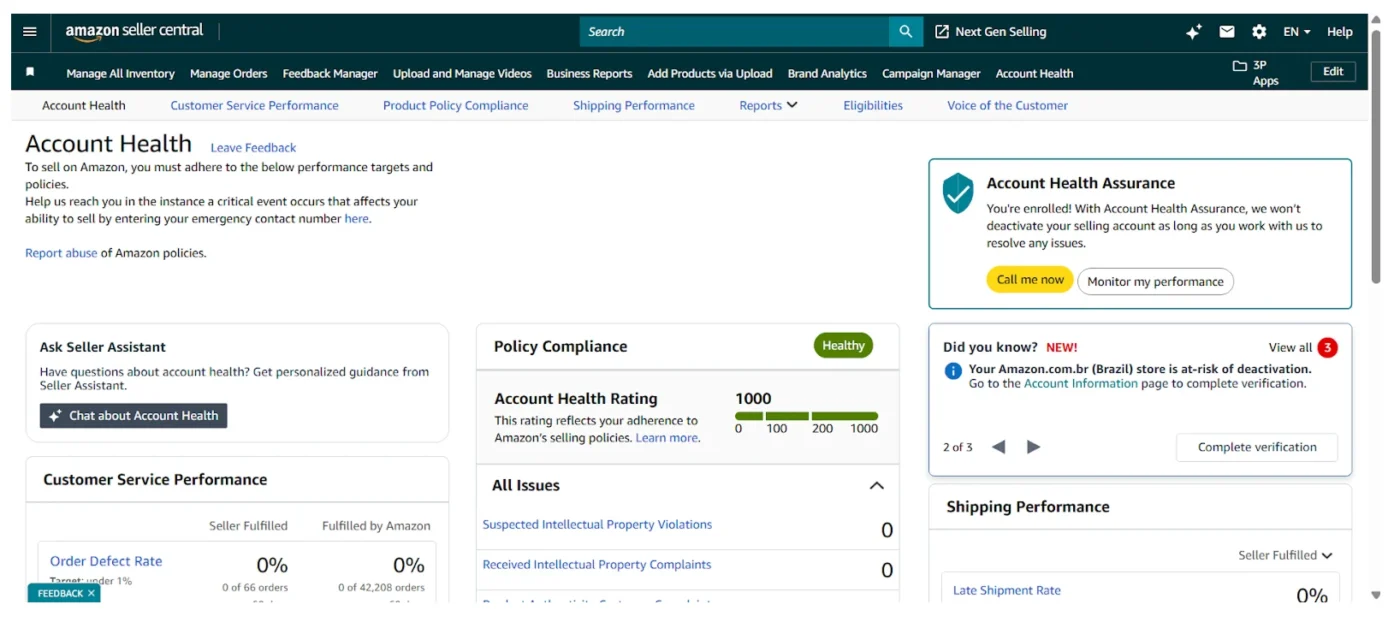
3. Manage Shrinkage and Inventory Loss
- The shortened reimbursement windows under the new policy require faster, more disciplined reconciliation.
- Here are the steps you need to follow:
- Monitor unsellable and damaged return reports weekly from your FBA Inventory Adjustments and Reimbursements tabs.
- Track shrinkage which is the difference between shipped and sellable units. It will help you quantify your true inventory loss rate.
- File claims within the new 15–75 day or 60–120 day windows, depending on return type.
- Use automation or third-party tools (like Seller Assistant App or Getida) to flag unclaimed reimbursements before they expire.
Accurate tracking prevents revenue leakage and ensures you recover full value from Amazon when damage or loss isn’t your fault.
4. Protect Account Health
Amazon now tightly links return behavior with overall account standing. Frequent complaints, high return rates, or policy violations can quickly affect your Account Health Rating (AHR).
To safeguard your seller status:
- Regularly review Account Health → Policy Compliance for warnings or product policy violations.
- Respond to “Used sold as new,” “Not as described,” or “Defective item” complaints within 48 hours.
- Prepare clear corrective action plans (CAPs) when appealing any suspension or listing block. CAPs should include:
- Root cause analysis (what caused the issue)
- Immediate corrective steps (what’s fixed)
- Preventive measures (how it won’t recur)
Maintaining quick, factual responses to Amazon’s alerts keeps your account in good standing and protects eligibility for FBA reimbursement claims and Buy Box access.
5. Set Smarter Restocking & Refund Rules
Use the new customization tools introduced in 2025 to fine-tune your post-return strategy.
- Restocking Fees:
Set category-specific rates that reflect true inspection and handling costs. For example:
- 20% restocking for opened electronics
- 10% for apparel worn once
- 0–5% for sealed, resellable items
- Returnless Refunds:
Configure thresholds for low-cost or non-resellable items (e.g., under $25) to avoid unnecessary shipping and labor costs.
- SKU-Level Adjustments:
Apply specific refund and restocking rules for high-volume ASINs with known return patterns. This rule-based automation not only preserves margins but also reduces manual decision-making, ensuring consistent customer treatment and faster refund resolution.
6. Improve Listing Accuracy & Product Quality
Most preventable returns stem from inaccurate listings and low product presentation standards.
Under the Amazon changing return policy, Amazon’s systems cross-reference product detail accuracy more closely with customer feedback and return reasons.
Below are the key improvement actions
- Update Titles & Bullet Points: Ensure measurements, materials, and specifications are accurate and easy to scan.
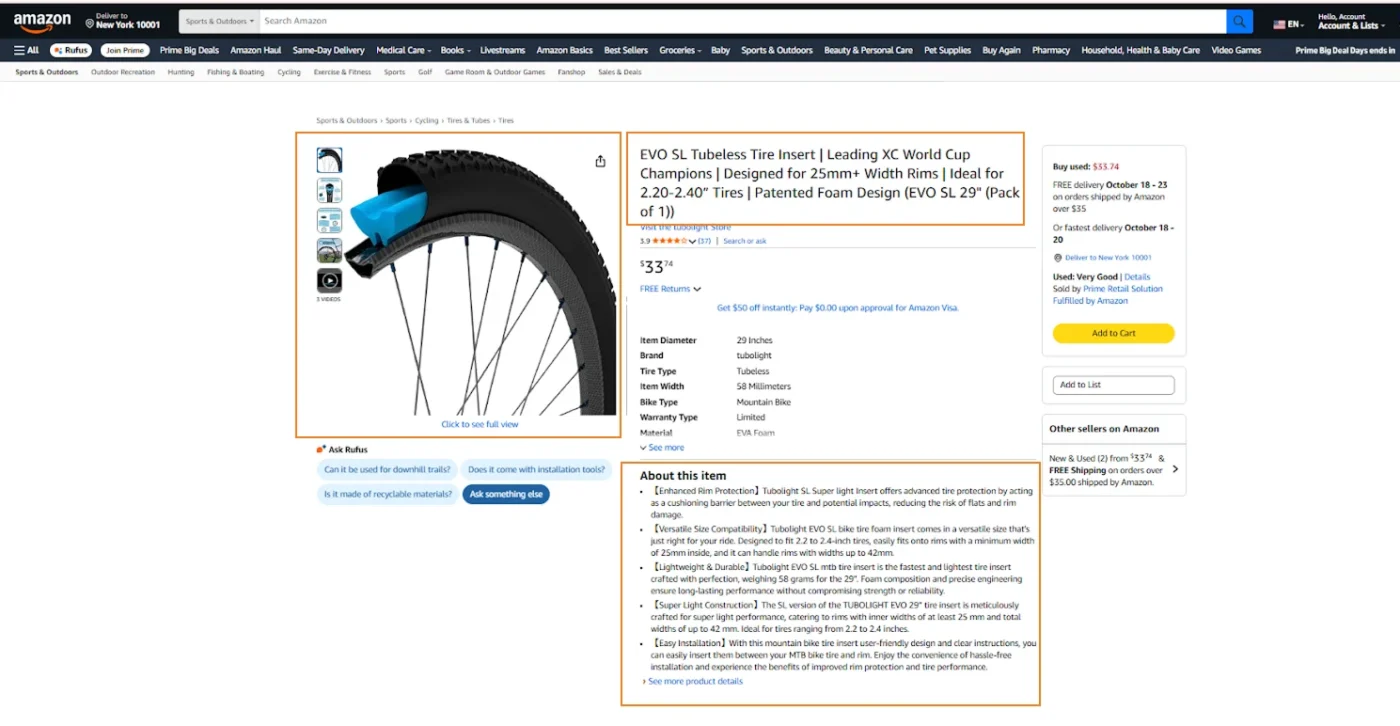
- Use High-Resolution Images: Include lifestyle shots, close-ups, and packaging views to manage buyer expectations.
- Add A+ Content: Use comparison charts, FAQs, and “What’s Included” modules to eliminate confusion.
- Integrate Customer Feedback: Analyze common buyer complaints in reviews and return notes, then update your listings or packaging accordingly.
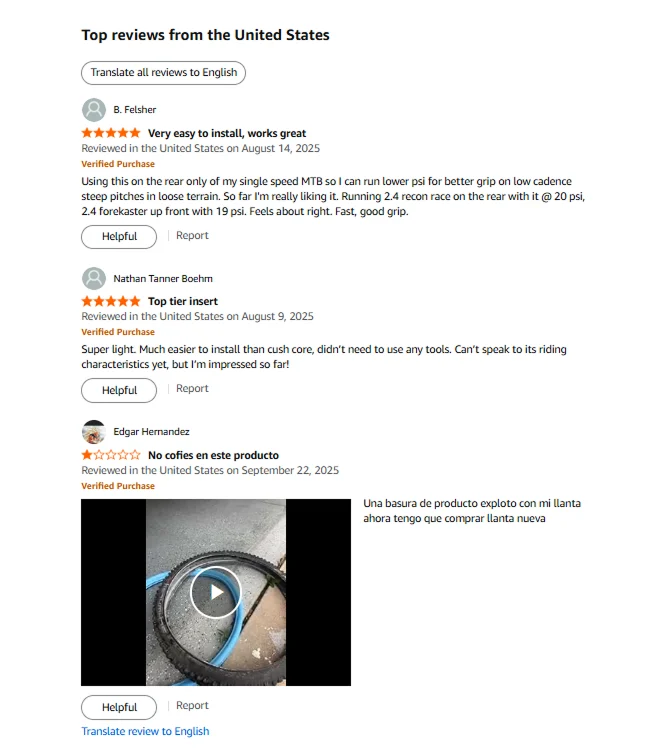
Establish a quarterly listing audit process to confirm that every product’s data aligns with the actual inventory shipped from FBA. Sellers who maintain accurate, trustworthy listings see lower NCX rates, reduced return costs, and stronger conversion performance.
Impact on Sellers of Amazon Changing Return Policy
The Amazon return policy change 2025 brings both advantages and new responsibilities. While sellers gain more flexibility and control, they must also maintain stronger compliance and quality discipline to stay competitive.
Benefits
1. Easier Global Sales with Local Returns
By allowing international customers to return items to local addresses, Amazon reduces shipping barriers and boosts buyer trust which makes cross-border selling faster, cheaper, and more scalable for FBA brands.
2. Fairer Restocking and Reimbursement Handling
Customizable restocking fees and clearer damaged-item reimbursement processes mean sellers are finally compensated in line with actual handling and inventory costs, reducing financial loss per return.
3. Better Alignment Between Seller Cost and Buyer Experience
The 2025 framework encourages balanced operations. It rewards accurate listings, quality control, and fast issue resolution. Sellers that maintain low return rates enjoy higher profitability and improved customer satisfaction metrics.
Challenges
1. New Fees and Higher Compliance Expectations
Return processing fees and shorter reimbursement claim windows demand tighter oversight. Sellers who fail to track returns proactively risk margin erosion and missed compensation opportunities.
2. Tighter Monitoring of NCX and Complaint Rates
Amazon’s enhanced focus on the Negative Customer Experience (NCX) rate means even minor listing errors or fulfillment issues can affect account health. Continuous performance monitoring is now essential to maintain policy compliance and Buy Box eligibility.
Conclusion
Amazon’s return policy change 2025 represents the platform’s continued evolution toward data-driven seller accountability and enhanced buyer satisfaction.
While it introduces new costs and stricter oversight, it also empowers FBA sellers to manage returns strategically which ultimately helps them reduce friction, protect margins, and strengthen brand trust in the process.
Smart sellers will not only comply but also use these updates to gain a competitive edge in the world’s largest e-commerce marketplace.




